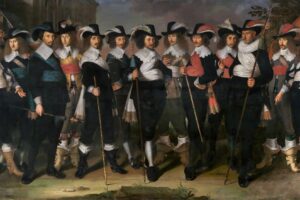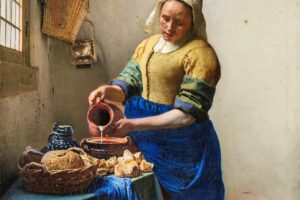A Tense Moment in Myth
In this emotionally charged painting, Jacques-Louis David captures a powerful moment from Greek mythology—the fury of Achilles as he is forced to give up his beloved bride-to-be, Briseis. The setting is noble, solemn, and tense. We see a world where war, duty, and personal emotion all crash into one another. This is not a battlefield scene, but a private one, brimming with inner conflict and suppressed pain.
A Warrior Torn in Two
At the heart of the image stands Achilles, the legendary warrior of the Trojan War. He is young, strong, and armored, yet his posture reveals turmoil. His arm pulls slightly toward Briseis, but his face is turned away, his jaw clenched. His honor has been wounded, and pride now wars with love. The deep blue of his robe contrasts sharply with the red cloak of Agamemnon, the king who demands Briseis be handed over.
Briseis: Silent in Sorrow
Briseis, delicate and dressed in white with a crown of flowers, stands between the two men, both figuratively and literally. Her hands rest gently over Achilles’ forearm—one last soft connection before being taken away. Her head bows in sadness, eyes cast down, showing quiet strength and heartbreak. Behind her, a regal woman—perhaps a priestess or queen—guides her forward, sharing her sorrow with a maternal gaze.
Agamemnon’s Cold Authority
On the right stands Agamemnon, king and commander. His presence is commanding but aloof. He points assertively toward Briseis, his expression firm, almost indifferent. He does not see the heartbreak—only the command. He represents law, power, and control, untouched by the emotions rippling through the scene.
Beauty in Restraint
David paints this moment with the grace of sculpture. The figures are strong yet still, the colors bold yet harmonious. There is no shouting, no wild gesture, yet the emotional charge is undeniable. Every glance and gesture tells the story: the struggle between power and emotion, between honor and affection.
A Story that Still Speaks
Though drawn from ancient legend, this painting speaks to timeless truths. It shows the cost of pride, the pain of parting, and the quiet strength of love under pressure. The Anger of Achilles invites us to pause not at the clash of swords, but at the deeper wounds of the heart—the ones we hide behind silence, armor, and dignity.
About Artist

Jacques-Louis David (1748–1825) was a French painter who became the leading figure of Neoclassicism, a movement that rejected the frivolity of the Rococo and sought to revive the moral and aesthetic values of ancient Greece and Rome. His art was not just beautiful; it was a powerful tool for political and social change. David’s work defined a new style that was severe, intellectual, and deeply political, making him a central figure in the French Revolution and later, the court of Napoleon Bonaparte.
Artistic Style and Legacy
David’s style is characterized by a dramatic shift from the soft, sensual curves of Rococo to the sharp lines and moral clarity of Neoclassicism. His paintings are known for:
- Classical Themes and Heroes: He drew heavily from ancient history and mythology to tell stories of virtue, civic duty, and self-sacrifice.
- Sharp, Defined Lines: He rejected the loose brushwork of the Rococo in favor of crisp, sculptural forms that give his figures a sense of heroic grandeur.
- Moral and Political Messages: His art often served as propaganda, urging viewers to embrace patriotism and civic virtue.
- Controlled Lighting: He used strong, raking light to emphasize form and clarity, avoiding the dramatic tenebrism of the Baroque.
Artwork Profile
Here paintings represent the full range of his career, from his early Neoclassical masterpieces to his later works for Napoleon.
- Belisarius Begging for Alms (1781): An early Neoclassical work that depicts the Roman general Belisarius, unjustly fallen into disgrace, begging for money. It’s a clear moral statement about the cruelty of the state.
- The Lictors Bring to Brutus the Bodies of His Sons (1789): A powerful and stark depiction of a Roman leader who chose civic duty over personal love. This painting, with its clear composition and somber tone, was seen as a call for revolutionary sacrifice.
- The Farewell of Telemachus and Eucharis (1782): A more sentimental and intimate work from his early career, it depicts a scene from a classical novel, showing his softer side before his full turn to political subjects.
- The Death of Socrates (1787): One of his most famous masterpieces. It portrays the Greek philosopher Socrates as a moral hero calmly facing death. The painting’s noble composition and stoic emotion made it an icon of Enlightenment ideals.
- The Anger of Achilles (1819): This late painting, from his exile in Brussels, shows David returning to classical subjects with a more refined and emotionally charged style.
- Oath of the Horatii (1784): Arguably his most famous work and a manifesto of Neoclassicism. It depicts three Roman brothers swearing an oath to their father, prioritizing duty to Rome over family. Its stark, geometric composition and powerful moral theme made it an instant sensation.
- Napoleon Crossing the Alps (1801): A famous equestrian portrait of Napoleon as a heroic figure. The painting is a work of political propaganda, portraying Napoleon as a dynamic and determined leader.
- The Emperor Napoleon in His Study at the Tuileries (1812): A more intimate portrait of Napoleon, but one that still emphasizes his power and intellectual prowess. It shows the emperor standing in his study late at night, a subtle nod to his tireless work ethic.



